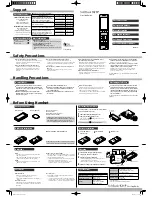
SNV-12 Operations Manual
5-29
5.23
Pilot Tone AGC
Each SVM can be set to run a DSP AGC algorithm to automatically adjust the levels of RX
audio receptions. This AGC is intended to compensate level changes in the link between each
remote receiver site and the SNV-12. It is not intended to compensate the different volume
levels of different system users. The AGC tracks the level of the pilot tone input; if it changes,
the SVM‟s internal DSP gain is changed to compensate. This feature uses changes in the
incoming pilot tone level as an indication of changes in the overall incoming RX signal level,
which may result, for example, from gain changes in a microwave link. The AGC gain setting
varies only when pilot tone is present and "freezes" when the pilot tone disappears. Thus, the
gain applied to each individual transmission from a system user depends on the level of the
pilot tone that preceded it at the SVM‟s RX audio input.
See Section 3.12.6.5 for full installation and operation instructions.
5.24
Pilot Tone Notch Filter Disable
It may be important in some special cases that there are no notch filters present in the normal
RX audio passband. One instance is when encrypted audio is being voted, and part of this
audio has been moved to the same part of the spectrum where the pilot tones reside*. Each
SVM can be individually set to run its pilot tone notch filter only when a pilot tone is detected
in its RX audio input. (Note: Pilot tone notch filters are normally enabled only if an SVM is set
to Pilot Tone COR, and only at the specified pilot tone frequency.)
When this feature is enabled, the SVM does not run its DSP notch filter algorithm until it
detects a pilot tone. Some time is required to detect this tone, so it will be present in the voted
audio output (and, when Repeat Mode is used, in the retransmitted voted audio). This
momentary bit of pilot tone will be heard at the end of each voting sequence. As soon as the
pilot tone is detected in all sites, the voting sequence is ended and the voted audio output is
muted.
(*Note that for the encrypted audio example given above: the SVM measures noise from 2300
to 3k Hz. The SVM expects that there is mostly noise only at these frequencies, with most
speech components from 300 to 800 Hz. If the encryption mode inserts speech energy into the
2300 to 3k Hz range, the voting algorithm may be affected. If poor voting performance is
noticed, it may be helpful to use Voting Lock on Active COR. In this mode, the voter makes a
quick initial vote and holds it until all sites squelch. This initial vote usually occurs before
speech is present in the RX input.)
See Section 3.12.6.5 for full installation and operation instructions.
Содержание SNV-12
Страница 12: ...SNV 12 Operations Manual 12 This page intentionally left blank ...
Страница 22: ......
Страница 32: ...SNV 12 Operations Manual 3 4 SNV 12 Figure 3 1 Outline Dimensions ...
Страница 75: ...SNV 12 Operations Manual 3 47 ...
Страница 113: ...SNV 12 Operations Manual 3 85 Figure 3 12 SVM 1 Remote Receiver Audio Input ...
Страница 120: ...SNV 12 Operations Manual 3 92 Figure 3 19 SVM 2 for Type I Signaling ...
Страница 121: ...SNV 12 Operations Manual 3 93 Figure 3 20 SVM 2 for Type II Signaling ...
Страница 122: ...SNV 12 Operations Manual 3 94 Figure 3 21 SVM 2 for Type III Signaling ...
Страница 123: ...SNV 12 Operations Manual 3 95 Figure 3 22 SVM 2 for Type V Signaling ...
Страница 125: ...SNV 12 Operations Manual 3 97 Figure 3 24 CIM 2 for Type II Signaling ...
Страница 126: ...SNV 12 Operations Manual 3 98 Figure 3 25 CIM 2 for Type III Signaling ...
Страница 127: ...SNV 12 Operations Manual 3 99 Figure 3 26 CIM 2 for Type V Signaling ...
Страница 130: ......
Страница 142: ...SNV 12 Operations Manual 4 12 End of Section 4 ...
Страница 145: ...SNV 12 Operations Manual 5 3 Figure 5 1 RX Audio Delay ...
Страница 172: ...SNV 12 Operations Manual 5 30 This page intentionally left blank ...
Страница 196: ...SNV 12 Operations Manual 6 24 This page intentionally left blank ...
Страница 202: ......
















































